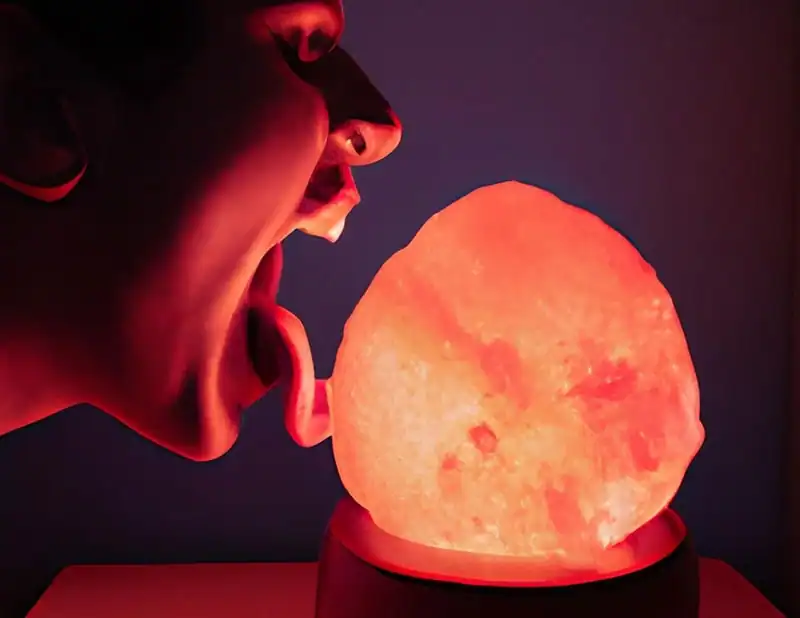To lick your Himalayan salt lamp or to not lick a salt lamp … this, weirdly enough, is a question I’ve seen pop-up on various forums and Facebook posts. It seems that many people are curious about the potential benefits or risks of licking a Himalayan salt lamp, so I thought I’d tackle the research and cover it in this post.
While it may be tempting to lick your Himalayan salt lamp out of curiosity or as a joke, I’ll explain why it’s actually not that great of an idea. Keep reading to learn more about the potential risks and drawbacks of licking a Himalayan salt lamp, and why you shouldn’t deem it a food group.
Can I Lick My Himalayan Salt Lamp?
Generally, it’s not recommended to lick a Himalayan salt lamp. While the salt is not harmful to humans, it is not meant to be ingested and could potentially contain contaminants.
Additionally, the lamp may have picked up other substances or contaminants from the air, which could be harmful if ingested. It is best to avoid licking the lamp and instead enjoy its aesthetic properties by simply using it as a decorative item or light source.

Is It Safe To Lick a Salt Lamp?
Himalayan salt itself is not harmful to humans and is often used as a seasoning or as a natural remedy for certain health conditions. However, it is not meant to be ingested in large quantities, so it is not recommended that you not lick a salt lamp. Also, you just don’t know where that lamp has been.
The salt may be rough or jagged, and the lamp may have picked up other substances or contaminants from the air that could be harmful if ingested. Licking a Himalayan salt lamp is not a hygienic practice, as the lamp may have been handled by other people or exposed to dust or other contaminants.
Remember, any salt…Himalayan or otherwise…that is used in cooking will have been processed and deemed safe to eat by the FDA or other food governing board. Lamps don’t go through those same tests and protocols because they are not food. It is possible that in a salt mine, not all of the deposits are food safe, so the non-food safe areas would be used for non-food products, such as lamp or candle holders.
A lot of times salt lamps are either sitting out unpackaged in the store, or have had their packaging opened and handled by dozens if not hundreds of people. The person who packaged it in Pakistan (the source for most Himalayan Pink salt) is unlikely to be considering food safety when handling lamps. That being said, salt is a fairly hostile environment for bacteria, so a salt lamp is no more ‘dirty’ than anything you buy in a store.
Would Licking A Himalayan Salt Lamp Taste Salty?
Yes.
Interviewer: “Have you ever licked a salt lamp?” Me: “Yup.”
Interviewer: “What did it taste like?” Me: “Salt.”
Interviewer: “Did it taste good?” Me: “Not particularly.”
Interviewer: “Why did you do that?” Me: “In the name of research.”
Interviewer: “Would you do it again?” Me: “Nope. No need to. I know what it tastes like now.”
Interviewer: “Did you get sick?” Me: “No. It was a really small lick.”
;)

Are Salt Lamps Toxic for Pets?
The salt in the lamp is not toxic to pets anymore than it is toxic for humans, The lamp itself does not pose a significant risk to pets if it is licked. However, it is generally not recommended for pets to lick or chew on salt products of any kind.
If your pet continues to try to lick a salt lamp, it may be a sign of other dietary problems. You should contact your veterinarian to evaluate the behavior. If for some very rare reason you think your pet has actually ingested a piece of a salt lamp or candle holder, do contact your vet immediately. Signs of over-ingestion of salt include: confusion, staggering, vomiting, and seizures – if you observe any of these, be sure to contact your vet immediately!
It is a good idea to try to keep salt lamps out of the reach of dogs. My dogs show absolutely no interest in salt lamps or salt candle holders, but your pet may be different. Cats are more difficult to control, of course. My daughter has observed that high shelves without a clear landing zone tend to discourage her cats – this goes for any breakable or electrified item. Something as heavy as a Salt Lamp should be carefully protected from being knocked off a shelf – and would damage a pet underneath it far more than licking the lamp surface!
Got a saltwater aquarium? Don’t place any item made from Himalayan salt blocks in your tank. Even if it seems like good decor for a salty environment, the salt block will dissolve and may adversely affect your total salinity level. The trace elements in the salt, especially Copper, are not at all good for your critters. Copper in particular can be toxic for invertebrates. For more about salt in aquariums, see our article on Aquarium Salt Safety.
Can I Use The Salt From My Himalayan Salt Lamp In Food?
It is not recommended to use the salt from a Himalayan salt lamp in food since the salt is not treated or processed in any way. Due to not being processed as a food item, it is possible that it has contaminants from the air, such as dust or pollutants, which could affect its purity and safety for use in food.
Additionally, the salt from a Himalayan salt lamp may have absorbed moisture from the air, which could make it less suitable for use as a seasoning. Moist salt may clump together and may not be as effective in seasoning food as dry salt.
I suppose that there could be ultra-recyclers out there that would like to use the salt from an old lamp that they are getting rid of, but this really is not a good idea. Even if you throughly cleaned the lamp first, you don’t know that the salt block itself didn’t start out with impurities.
If you want to use Himalayan salt in your cooking or as a seasoning, it is best to purchase food-grade Himalayan salt from a reputable source. This will ensure that the salt is pure and safe for use in food. It is also a good idea to store the salt in an airtight container to preserve its quality and prevent it from picking up any contaminants.
Final Thoughts
If you really can’t help being curious, if you lick a salt lamp once, I think you will survive. I did. Frankly though, the food-grade pink Himalayan salt that I buy for my salt grinder is far, far more tasty.







